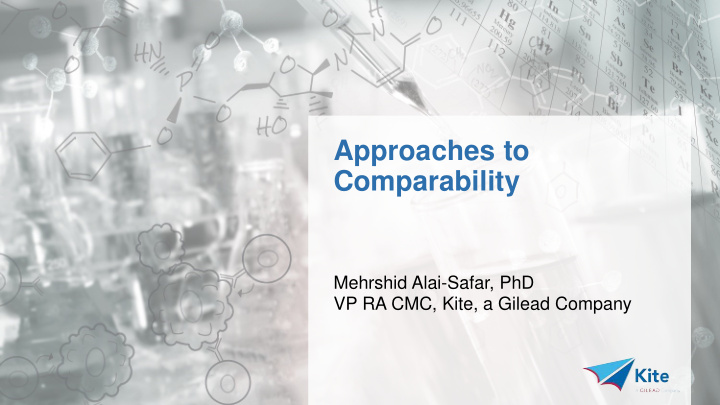



Approaches to Comparability Mehrshid Alai-Safar, PhD VP RA CMC, Kite, a Gilead Company
Process Comparability Key to Managing Process Changes Required Process Consistency Manufacturing Process Comparability Required Product Quality 2
Process Characterisation is the Foundation Process Clinical Process & + Manufacturing Performance Characterization Data Data Parameters Ongoing Process Monitoring Process Characterisation Stages Stage 1: A formal risk Process Qualification / Validation assessment of the process Process Characterisation Stage 2: Execution of formal studies at scale [Study Data, Published Articles, pFMEA results, Unit Operations] 3
Equivalence or Expectation – Which Approach? Equivalence Expectation • Changes that cannot be • Change Supported by characterized Characterization Data at Scale • Limited in-process Data • Increased in-process Data • Early Tech Transfer (Clinical to • Tech Transfer after Extensive Commercial) Manufacturing Experience • Runs Performed Under Controlled • Run more Representative of Patient Conditions Data • Limited manufacturing experience • Utilize Historical Data from a Variety • Typically for CQAs of Sources for Acceptance Criteria 4
Kite has Used Equivalence & Expectation Approaches • Under both approaches, comparability included demonstrating a number of process parameters meeting the expected established ranges. – Individual measurements , rather than population means, were considered more suitable. – Tolerance interval approach was appropriate because the interest was in evaluation of individual lots rather than the average of several measurements. – The acceptance criteria for these parameters were derived from tolerance intervals calculated from full-scale runs . 5
Risk Assessment as Component of Comparability • As part of process comparability, a risk assessment is performed to determine which quality attributes should be considered for comparability. • Quality attributes are ranked for their criticality using a risk assessment approach that is based on 2 dimensions: – Severity: taking into account the risks associated with subject safety (eg, proper dosing) and product efficacy – Likelihood: defined as the probability of an adverse event (AE) that impacts safety and efficacy due to a quality attribute being out of control. – A risk priority number (RPN), which indicates the relative criticality of an attribute, is calculated by: RPN = Severity X Likelihood Scores* *CMC Biotech Working Group 2009 6
Stability as a Component of Comparability • Long-term stability studies have shown that product is stable over a long period of time once frozen and stored at appropriate temperature. • Risk assessment should be performed to evaluate whether the change may have an impact on stability – A short-term stability study can address any potential impact of the change on product stability (excluding changes to formulation or cryopreservation step). A long-term stability study may not be required for comparability purposes for CAR-T products 7
Concurrent Validation and Application to Comparability • EU GMP Guidance for ATMPs allows for concurrent process validation 1. Can comparability be executed with surrogate material at scale as part of process characterization, followed by concurrent validation using patient material? 2. Can patient product be released after meeting protocol acceptance criteria prior to filing the data package with regulators? • Concurrent validation approaches – 10.43 . Due to the limited availability of the starting materials and/or where there is a strong benefit-risk ratio for the patient, a concurrent validation may be acceptable. The decision to carry out concurrent validation should be justified and a protocol should be defined. Regular reviews of data from the manufacture of batches should be subsequently used to confirm that the manufacturing process is able to ensure that the specifications in the marketing authorization are complied with. – 10.44. Where a concurrent validation approach has been adopted, there should be sufficient data to support the conclusion that the batch meets the defined criteria. The results and conclusion should be formally documented and available to the QP prior to the certification of the batch. 8
Recommend
More recommend